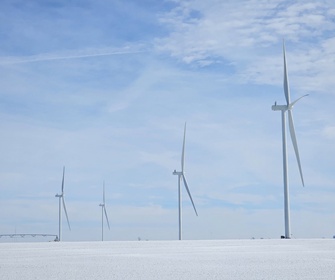Over the past year, the U.S. wind energy sector has demonstrated its resilience and potential, as highlighted in the 2024 editions of the annual market reports released by the U.S. Department of Energy (DOE). These reports—the Land-Based Wind Market Report, Offshore Wind Market Report, and Distributed Wind Market Report—indicate that the passage of the Inflation Reduction Act (IRA) has significantly increased near-term wind deployment forecasts and driven billions of dollars of investment in the domestic wind supply chain, despite ongoing industry challenges.
Last year, wind power supplied over 10% of U.S. electricity, accounted for 12% of new electricity capacity, represented $10.8 billion in capital investment, and supported more than 125,000 American jobs.
The reports show that near-term wind energy forecasts have increased by over 30% following the passage of the IRA, with growth expected to accelerate to more than 15 GW per year by 2026 and nearly 20 GW per year by the end of the decade. The IRA is also boosting supply chain expansion, with 15 new, re-opened, or expanded land-based wind manufacturing facilities announced since its passage.
Significant offshore wind growth is also expected in the coming years, with the U.S. project pipeline expanding by 53% over the past year. Projects totalling almost 6 GW of offshore wind capacity are currently under construction, with an additional 3 GW approved by the U.S. Department of the Interior’s Bureau of Ocean Energy Management (BOEM) and preparing to begin construction. Furthermore, there are more than 45 GW in state commitments.
The Land-Based Wind Market Report, prepared by DOE’s Lawrence Berkeley National Laboratory, highlights the addition of nearly 6,500 MW of new utility-scale, land-based wind capacity in 2023, bringing the total installed capacity to nearly 150,500 MW. Key findings include:
- Wind energy provided 10% of the nation’s total electricity, including more than 59% in Iowa, over 55% in South Dakota, and more than 40% in Kansas and Oklahoma.
- By the end of 2023, utility-scale, land-based wind was installed in 42 states, with 17 states adding new turbines in 2023. Texas led with 1,323 MW of new capacity, followed by Illinois and Kansas, each with over 800 MW.
- For the second time, non-utility buyers, such as corporations, purchased more wind energy than utilities. Direct retail purchasers, including corporate commitments, accounted for at least 48% of the new wind capacity installed in 2023.
- Wind turbines continue to grow in size and power, contributing to competitive costs and prices. The average capacity of newly installed turbines has increased by 23% since 2020, reaching 3.4 MW, while rotor diameters have grown by 7%, reaching 438 feet.
The Offshore Wind Market Report, prepared by DOE’s National Renewable Energy Laboratory, shows that despite recent macroeconomic challenges and supply chain constraints, the U.S. offshore wind industry is poised for significant growth. The U.S. offshore wind project pipeline grew by 53% over the past year, reaching a total of 80,523 MW. Projections suggest that the U.S. could have 40 GW of offshore wind capacity installed by 2035. Other key findings include:
- DOE estimates that $10 billion has been announced or invested in the U.S. offshore wind supply chain since 2021, with $2.1 billion invested in 2023 alone.
- Eight states have procurement mandates totalling more than 45 GW of offshore wind capacity by 2040.
- Floating offshore wind is becoming increasingly important in the U.S. pipeline. California now has over 6,000 MW of estimated pipeline capacity in the site control stage from five floating offshore wind projects, while the Gulf of Maine has over 15,000 MW in its pipeline from eight proposed lease areas.
- As of May 2024, the U.S. offshore wind pipeline includes 38 projects in permitting or under site control, totalling more than 42 GW, with an additional 30 GW in the planning stage.
- Although rising interest rates, supply chain constraints, and higher commodity prices have led to increased costs for offshore wind energy, these costs have decreased by more than 50% since 2013 when considering longer-term trends.
The Distributed Wind Market Report, prepared by DOE’s Pacific Northwest National Laboratory, notes that 1,999 distributed wind turbines were added across 16 states in 2023. Distributed wind turbines, which serve on-site energy demand or support local electricity distribution networks, added 10.5 MW of new capacity in 2023, representing $37 million in new investment. Key findings include:
- Cumulative U.S. distributed wind capacity now stands at 1,110 MW from more than 92,000 wind turbines across all 50 states, the District of Columbia, Puerto Rico, the U.S. Virgin Islands, the Northern Mariana Islands, and Guam.
- Ohio, Illinois, and Alaska led in distributed wind capacity additions in 2023, with three projects accounting for 78% of the capacity installed.
- Distributed wind is poised for growth, partly due to IRA funding opportunities and collaboration between DOE and the U.S. Department of Agriculture (USDA). In 2024, DOE and USDA launched the Rural Agricultural Income & Savings from Renewable Energy (RAISE) initiative, which aims to help 400 farmers deploy smaller-scale wind projects. DOE has made an initial investment of $4 million, and USDA is leveraging a $303 million fund for underutilised technologies, including distributed wind, through its Rural Energy for America Program (REAP).
- In 2023, 40 wind energy projects received $3.4 million in USDA REAP grants, the largest total in more than a decade.








